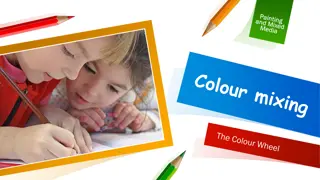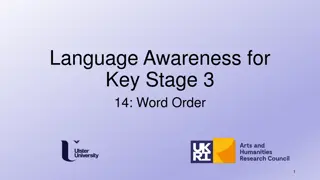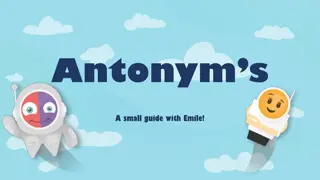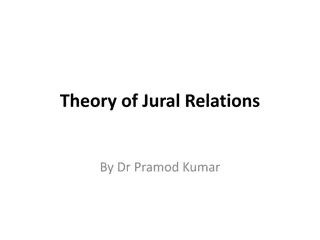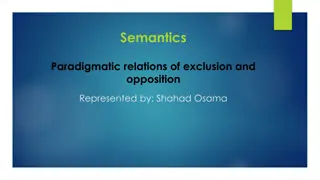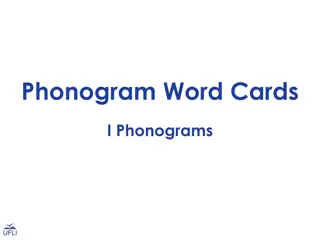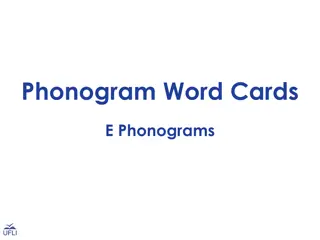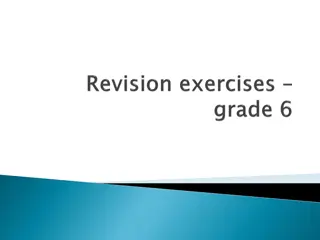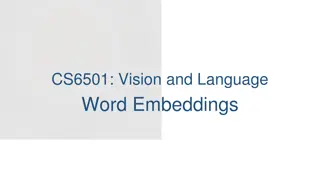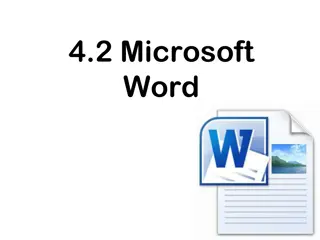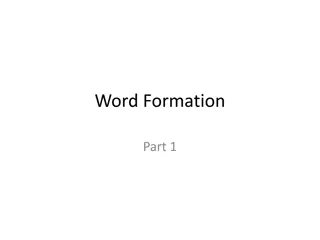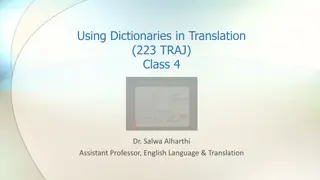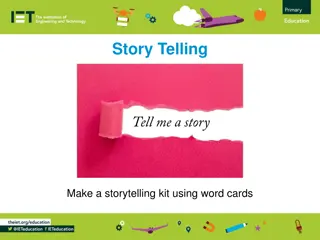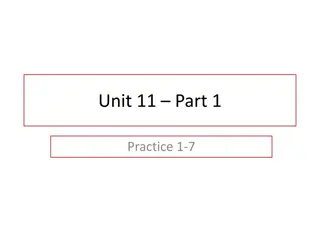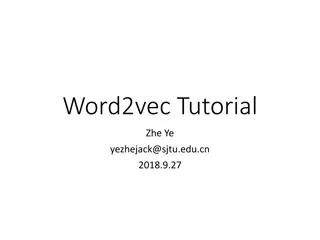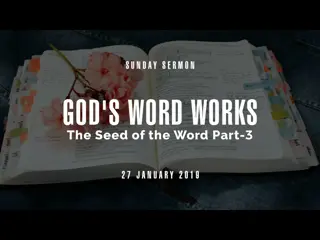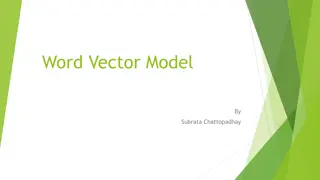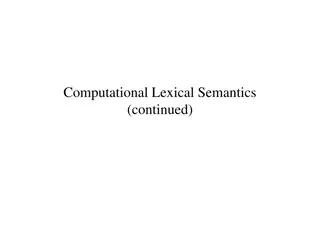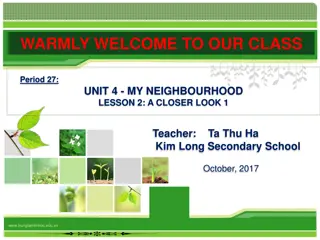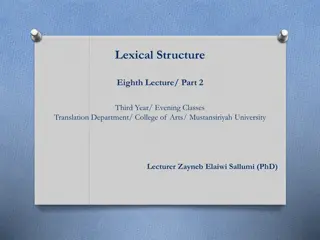Understanding Medical Word Elements: Roots, Combining Forms, Suffixes, and Prefixes
Medical terminology uses word elements like roots, combining forms, suffixes, and prefixes. Word roots provide the main meaning, combining forms connect elements, suffixes modify word meaning, and prefixes are placed at the beginning of words. Examples illustrate how these elements are used in medic
6 views • 13 slides
Understanding the Basics of Color Theory
A color wheel organizes colors into primary, secondary, and tertiary categories. Primary colors are red, blue, and yellow; secondary colors are green, violet, and orange; and tertiary colors are mixtures of primary and secondary colors. The value of a color refers to how light or dark it is, with ti
3 views • 10 slides
Stages of First Language Acquisition in Children
First language acquisition in children progresses through distinct stages including cooing and babbling, the one-word stage, the two-word stage, and telegraphic speech. These stages mark the development of speech sounds, single-word utterances, two-word combinations, and more complex speech structur
2 views • 16 slides
Understanding Lexical Relations: Synonyms, Antonyms, Hyponymy, and Prototype
Explore the concepts of synonyms, antonyms, hyponymy, and prototype in lexical relations. Learn how closely related words can be substituted for each other, understand opposites, inclusion in meanings, and characteristic instances in word categories.
0 views • 12 slides
Understanding Word Order in Different Languages
Explore the fascinating world of word order in languages. Discover how different languages arrange words in various ways, such as Subject-Verb-Object (SVO), Subject-Object-Verb (SOV), and more. Delve into the diversity of word orders for subjects, objects, and verbs, and uncover how language structu
2 views • 31 slides
Faithful Living and Preaching God's Word in 2 Timothy
In 2 Timothy, the call to preach the Word faithfully is emphasized, highlighting the importance of living with courage and commitment in spreading God's message. The text underscores the need to remain steadfast in the face of challenges and to uphold the truth of God's Word amidst changing times. T
0 views • 12 slides
Enhancing Vocabulary: Opposites, Prefixes, and Words with Common Prefixes
Explore a collection of opposites, prefixes, and words with common prefixes in this educational material. Discover words like unable, unbelievable, disapprove, and submerge to enhance your vocabulary and understanding of word formation.
0 views • 7 slides
Enhancing Vocabulary with Antonyms Guide
Explore the world of antonyms and learn how they enrich our language. Discover the power of identifying and using antonyms to enhance your vocabulary and writing skills. Uncover the importance of opposites in expanding your language proficiency and mastering English.
0 views • 11 slides
Engaging Word Sorting Activity for Students
Encourage student engagement with a hands-on word sorting activity involving phonograms. Students copy word cards into categories, read each word, and determine its appropriate category in a fun and interactive manner using a sorting chart.
2 views • 5 slides
Understanding the Theory of Jural Relations by Dr. Pramod Kumar
According to Dr. Pramod Kumar, the Theory of Jural Relations focuses on legal concepts like rights, duties, privileges, powers, immunities, liabilities, and more. By arranging these concepts as opposites and correlatives, the theory helps in understanding legal issues with clarity and practical exam
0 views • 9 slides
Semantics and Paradigmatic Relations of Exclusion and Opposition
The presentation explores the concepts of incompatibility, co-taxonymy, and opposition in semantics. It delves into how certain terms exclude others within a set and the various forms of opposition such as complementaries and antonymy. Examples like "Women, Queen, Mother, Servant, Teacher" illustrat
0 views • 21 slides
Understanding Word Sense Disambiguation: Challenges and Approaches
Word Sense Disambiguation (WSD) is a complex task in artificial intelligence that aims to determine the correct sense of a word in context. It involves classifying a word into predefined classes based on its meaning in a specific context. WSD requires not only linguistic knowledge but also knowledge
2 views • 12 slides
Understanding Operations with Integers
Integers are whole numbers and their opposites. Learn about addition, subtraction, multiplication, and division of integers. Follow specific rules based on the signs of the numbers involved to correctly perform operations. This educational presentation provides clear explanations and visual examples
0 views • 13 slides
Phonogram Word Cards for Phoneme-Grapheme Correspondences
Explore lists of words with the same phonograms to teach new phoneme-grapheme correspondences, ideal for review games like Word Sorts and other activities requiring phonogram-based word lists. Enhance reading and spelling skills through engaging practices with word groups like nice, price, rice, sli
1 views • 26 slides
Phonogram Word Cards for Teaching Phoneme-Grapheme Correspondences
Explore a collection of phonogram word cards featuring various phoneme-grapheme correspondences for educational activities like word sorts and review games. Enhance phonics skills with word lists containing words sharing the same phonogram, covering a wide range of graphemes and phonemes. Utilize th
0 views • 32 slides
Understanding Word Meaning in Lexical Semantics
Introduction to Chapter 5 Lecture 4.1 discusses the nature of word meaning, major problems of lexical semantics, and different approaches. It explains the concept of a word, prototypical words, lexical roots, lexemes, and word forms, highlighting the importance of the word as a lexeme in lexical sem
1 views • 20 slides
Lucid Dream Experiment Analysis: Unveiling Psyche Imbalances Through Dream Exploration
Delve into the lucid dream experiment conducted at the IASD Conference in Anaheim in June 2017, where participants delved into dream narratives to uncover psychological imbalances. By tracing basic symmetrical movements in dreams, the study aimed to explore how conscious interactions within dreams c
0 views • 30 slides
English Grammar Practice - Verb Forms, Opposites, and Examples
Enhance your English grammar skills by practicing verb forms, identifying opposites, and understanding sentence examples. Improve your language proficiency with exercises on verb conjugation, word pairs, and sentence structure. Explore various topics such as daily routines, preferences, location, an
0 views • 8 slides
Understanding Latin and Greek Prefixes and Suffixes in Medical Terminology
Explore the world of Latin and Greek prefixes and suffixes used in medical terminology. Discover opposites, word formations, and the meanings behind various prefixes. Test your knowledge with statements and synonyms, and practice forming terms based on definitions.
0 views • 18 slides
Contraries, Proverbs, and Marriage: Understanding Blake's The Marriage of Heaven and Hell
Blake's The Marriage of Heaven and Hell challenges traditional moral concepts, portraying Hell as a realm of unrestrained energy opposed to the regulated Heaven. The book explores contraries rather than opposites, emphasizing the necessity of both devils and angels in human progression. The Proverbs
0 views • 5 slides
Exploring Word Embeddings in Vision and Language: A Comprehensive Overview
Word embeddings play a crucial role in representing words as compact vectors. This comprehensive overview delves into the concept of word embeddings, discussing approaches like one-hot encoding, histograms of co-occurring words, and more advanced techniques like word2vec. The exploration covers topi
1 views • 20 slides
Understanding Microsoft Word: Features and Functions
Explore the key components and objectives of Microsoft Word, a versatile word processing tool in the Microsoft Office Suite. Learn about the user interface, commands, text manipulation, keyboard shortcuts, working with pictures and language tools, and the benefits of using word processing software.
0 views • 29 slides
Understanding Word Formation and Coinage in English
Word formation in English involves different processes such as compounding, conversion, and derivational affixation. Compounding combines two or more words to create a new word, while conversion changes the word class without affixes. Word coinage includes compounds, acronyms, back-formations, abbre
0 views • 10 slides
Understanding the Role of Dictionaries in Translation
Dictionaries play a crucial role in translation by helping users find information about linguistic signs, word division, spelling, and word formation. The lemma serves as a representative of a lexical item in a dictionary, aiding users in locating specific entries. Word division information can assi
0 views • 12 slides
Creative Word Play Storytelling Kit
Unleash your creativity with the Creative Word Play Storytelling Kit using word cards. Safely cut out and sort the word cards into piles representing different parts of speech. Create unique sentences by combining cards from each pile and let your imagination run wild as you build stories. Expand th
0 views • 6 slides
Understanding Analyticity and Antonymy Concepts
Explore concepts like analyticity, paraphrases, antonymy, and binary antonyms in this practice exercise. Learn about sense relations, contradictory statements, and word opposites. Dive into identifying binary antonyms and understanding four-way contrasts. Enhance your understanding of semantics and
0 views • 39 slides
Understanding Word Vectors and Training with Gensim
Explore the differences between one-hot representation and word vectors, learn about virtual environments in Python for training word vectors, and dive into the process of evaluation, analogy, and word clustering. Discover tools like Anaconda and Virtualenv, popular libraries like Gensim, and the si
0 views • 16 slides
Understanding Text Similarity Techniques in NLP
Explore various text similarity techniques in Natural Language Processing (NLP), including word order, length, synonym, spelling, word importance, and word frequency considerations. Topics covered include bag-of-words representation, vector-based word similarities, TF-IDF weighting scheme, normalize
2 views • 62 slides
Understanding the Parable of the Sower and Receiving God's Word
The Parable of the Sower teaches us how to receive and nurture God's Word in our hearts to produce fruit in our lives. Through the seed of God's Word, we learn the importance of protecting, understanding, and guarding our hearts from distractions and challenges that may hinder its growth and impact.
0 views • 24 slides
The Power of the Word: Lessons on Faith Chapter 17
Discover the profound impact of the Word of God on our lives as portrayed in Lessons on Faith Chapter 17. Just as the earth thrives with rain and snow, our lives flourish with the Word. Embrace the transformative power of God's Word and let it work within you to bring forth righteousness and peace.
0 views • 13 slides
Comprehensive Study of Opposites and Prefixes in Student Book and Workbook
Explore the world of opposites and prefixes through engaging activities in the Student Book on page 130 and corresponding exercises in the Workbook on page 60. Discover words like "unable," "impossible," "immovable," and more while learning about prefixes like "un-" and "im-." Uncover the meanings a
0 views • 7 slides
The Sunday of the Word of God Celebration - 24th January 2021
The Sunday of the Word of God, observed on the 24th of January 2021, is dedicated to the celebration, study, and dissemination of the Word of God. Pope Francis encourages Catholics worldwide to deepen their relationship with God through His Word. The event highlights the importance of valuing both t
0 views • 27 slides
Understanding Word Vector Models for Natural Language Processing
Word vector models play a crucial role in representing words as vectors in NLP tasks. Subrata Chattopadhyay's Word Vector Model introduces concepts like word representation, one-hot encoding, limitations, and Word2Vec models. It explains the shift from one-hot encoding to distributed representations
0 views • 25 slides
Vocabulary Lessons: Nature, Disaster, Evolution, and Migration
Enhance your vocabulary with lessons on nature, disaster, evolution, and migration. Practice completing sentences and finding word opposites to improve your language skills. Engaging exercises and images included.
0 views • 11 slides
Understanding Word Sense Disambiguation in Computational Lexical Semantics
Word Sense Disambiguation (WSD) is a crucial task in Computational Lexical Semantics, aiming to determine the correct sense of a word in context from a fixed inventory of potential word senses. This process involves various techniques such as supervised machine learning, unsupervised methods, thesau
0 views • 67 slides
Explore My Neighbourhood: Vocabulary, Opposites, and Questions
Dive into Unit 4 Lesson 2 of My Neighbourhood, covering adjectives to describe areas, vocabulary words like "fantastic" and "polluted," matching adjectives with their opposites, and practicing asking and answering questions about neighbourhood features. Enhance your language skills with interactive
0 views • 13 slides
Exploring the Concept of Ying Yang and Opposites in Nature
The Yin Yang symbol represents the balance of opposite energies in nature, where complementary forces can work together harmoniously. This article delves into the significance of opposites, showcases different Ying Yang designs, encourages creativity in designing your own symbol, and explores the co
0 views • 7 slides
Understanding Morphology in Linguistics
Morphology is a branch of linguistics that focuses on word structure and the smallest meaningful units of language known as morphemes. It delves into the decomposition of words and the classification of morphemes into bound and free categories. Bound morphemes, such as prefixes and suffixes, modify
0 views • 16 slides
Understanding Lexical Structure: Antonymy, Hyponymy, and Components
Antonymy refers to words with opposite meanings, divided into gradable and non-gradable categories. Hyponymy involves one term's meaning being included in another. Relational opposites show reversal of relationships, while componential analysis breaks down word meaning into distinct elements.
0 views • 7 slides
Biblical Faith and Obedience in Action: Just Believe and Obey God's Word
The statement "Thy word is settled in Heaven" highlights the authority and power of God's word, emphasizing the fulfillment of His promises. Belief, knowledge, reasoning, and obedience are all interconnected in expressing true faith as illustrated through various biblical references. The call to "Ju
0 views • 6 slides

